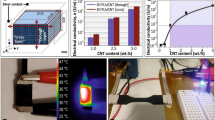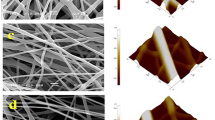Abstract
Nanofibers with multifunctional properties hold great promise as they allow components for a wide range of medical applications. In this study, zinc oxide, silver nitrate and Polycaprolactone were used in the production of nanofiber composite material by coaxial electrospinning process. PCL concentrations of 5, 10, and 15% by weight were utilized in all of the samples, and different amounts of silver nitrate and zinc oxide were used. Functional groups of silver nitrate, zinc oxide, and Polycaprolactone materials were determined by Fourier transform infrared spectroscopy. Morphological analyzes were carried out with scanning electron microscopy. For all solutions, before coaxial electrospinning, physical properties such as density, liquid state ac conductivity, and viscosity were measured. For the 20 Hz–3 MHz frequency range, after coaxial electrospinning, D-factors and capacitance of nanofiber composite materials were measured and dielectric loss, permittivity, and the solid-state alternating current conductivity were calculated for all solutions. The effects of silver nitrate, zinc oxide, and Polycaprolactone concentration percentages on the solid-state ac conductivity and the dielectric constant were analyzed and comparisons were made with the results obtained.








Similar content being viewed by others
Availability of data and materials
All raw data used in this manuscript are available and could be supplied upon request.
References
Akkurt I, Malidarre RB, Kartal I, Gunoglu K (2021) Monte Carlo simulations study on gamma ray–neutron shielding characteristics for vinyl ester composites. Polym Compos. https://doi.org/10.1002/pc.26185
Augustine R, Kalarikkal N, Thomas S (2016a) Electrospun PCL membranes incorporated with biosynthesized silver nanoparticles as antibacterial wound dressings. Appl Nanosci 6(3):337–344
Augustine R, George SC, Kalarikkal N, Thomas S (2016b) Gentamicin loaded electrospun poly (ε-caprolactone)/TiO2 nanocomposite membranes with antibacterial property against methicillin resistant Staphylococcus aureus. Polym Plast Technol Eng 55(17):1785–1796
Aydogdu MO, Ekren N, Suleymanoglu M, Erdem-Kuruca S, Lin C-C, Bulbul E, Erdol MN, Oktar FN, Terzi UK, Kilic O (2018) Novel electrospun polycaprolactone/graphene oxide/Fe3O4 nanocomposites for biomedical applications. Colloids Surf B 172:718–727
Cesur S, Oktar FN, Ekren N, Kilic O, Alkaya DB, Seyhan SA, Ege ZR, Lin CC, Kuruca SE, Erdemir G, Gunduz O (2020) Preparation and characterization of electrospun polylactic acid/sodium alginate/orange oyster shell composite nanofiber for biomedical application. J Aust Ceram Soc 56(2):533–543
Croitoru A-M, Karaçelebi Y, Saatcioglu E, Altan E, Ulag S, Aydoğan HK, Sahin A, Motelica L, Oprea O, Tihauan B-M, Popescu R-C, Savu D, Trusca R, Ficai D, Gunduz O, Ficai A (2021) Electrically triggered drug delivery from novel electrospun poly(lactic acid)/graphene oxide/quercetin fibrous scaffolds for wound dressing applications. Pharmaceutics 13:957
Dobrzański L, Hudecki A, Chladek G, Król W, Mertas A (2014) Surface properties and antimicrobial activity of composite nanofibers of polycaprolactone with silver precipitations. Arch Mater Sci Eng 70(2):53–60
Elumalai K, Velmurugan S, Ravi S, Kathiravan V, Ashokkumar S (2015) Bio-fabrication of zinc oxide nanoparticles using leaf extract of curry leaf (Murraya koenigii) and its antimicrobial activities. Mater Sci Semicond Process 34:365–372
Hou Q, Grijpma DW, Feijen J (2002) Preparation of porous poly (ε-caprolactone) structures. Macromol Rapid Commun 23(4):247–252
Kaya AU, Esmer K, Tekin N, Beyaz SK (2011) Investigation of temperature, thermodynamic parameters and dielectrical properties of poly (vinylimidazole)–Na–bentonite nanocomposite. J Appl Polym Sci 120(2):874–879
Kayiran HF (2022) Numerical analysis of composite discs with carbon/epoxy and aramid/epoxy materials. Emerg Mater Res. https://doi.org/10.1680/jemmr.21.00052
Komur B, Bayrak F, Ekren N, Eroglu M, Oktar F, Sinirlioglu Z, Yucel S, Guler O, Gunduz O (2017) Starch/PCL composite nanofibers by co-axial electrospinning technique for biomedical applications. Biomed Eng Online 16(1):40
Kuru TŞ (2021) Frequency dependence of dielectric, conductivity, impedance and electrical modulus properties of La3+ substituted in cobalt-magnesium ferrites. J Inst Sci Technol 11(1):240–257
Paneva D, Manolova N, Argirova M, Rashkov I (2011) Antibacterial electrospun poly (ɛ-caprolactone)/ascorbyl palmitate nanofibrous materials. Int J Pharm 416(1):346–355
Parlar Z, Abdlhamed A, Akkurt İ (2019) Gamma-ray-shielding properties of composite materials made of recycled sport footwear. Int J Environ Sci Technol 16:5113–5116. https://doi.org/10.1007/s13762-018-1876-7
Patil PT, Anwane RS, Kondawar SB (2015) Development of electrospun polyaniline/ZnO composite nanofibers for LPG sensing. Procedia Mater Sci 10:195–204
Raheman F, Deshmukh S, Ingle A, Gade A, Rai M (2011) Silver nanoparticles: novel antimicrobial agent synthesized from an endophytic fungus Pestalotia sp. isolated from leaves of Syzygium cumini (L.). Nano Biomed Eng 3(3):174–178
Saatcioglu E, Ulag S, Sahin A, Yilmaz BK, Ekren N, Inan AT, Palaci Y, Ustundag CB, Gunduz O (2021) Design and fabrication of electrospun polycaprolactone/chitosan scaffolds for ligament regeneration. Eur Polym J 148:110357
Singh NB, Su C-H, Choa F-S, Arnold B, Cooper C, Cullum B, Kelly L (2020) Morphology and performance of organic nanocomposites for γ-ray sensing. Emerg Mater Res 9–2:520–526. https://doi.org/10.1680/jemmr.18.00050
Uğur Kaya A, Güner S, Esmer K (2014) Effects of solution mixing temperature on dielectric properties of PMMA/Pristine bentonite nanocomposites. J Appl Polym Sci 131(4):39907(1–7)
Virovska D, Paneva D, Manolova N, Rashkov I, Karashanova D (2014) Electrospinning/electrospraying vs electrospinning: a comparative study on the design of poly (l-lactide)/zinc oxide non-woven textile. Appl Surf Sci 311:842–850
Acknowledgements
The authors report no acknowledgement for this work.
Funding
There is no funding for this work.
Author information
Authors and Affiliations
Contributions
All authors read and approved the final version of the manuscript for publication.
Corresponding author
Ethics declarations
Conflict of interest
The authors declare that there is no conflict of interest.
Rights and permissions
About this article
Cite this article
Kurt, U., Atis, S., Polat, Z. et al. A Study on Electrical Properties of Nanofiber Composites: Effects of PCL/AgNO3/ZnO Concentration Percentages. Iran J Sci Technol Trans Sci 46, 1045–1054 (2022). https://doi.org/10.1007/s40995-022-01299-1
Received:
Accepted:
Published:
Issue Date:
DOI: https://doi.org/10.1007/s40995-022-01299-1




